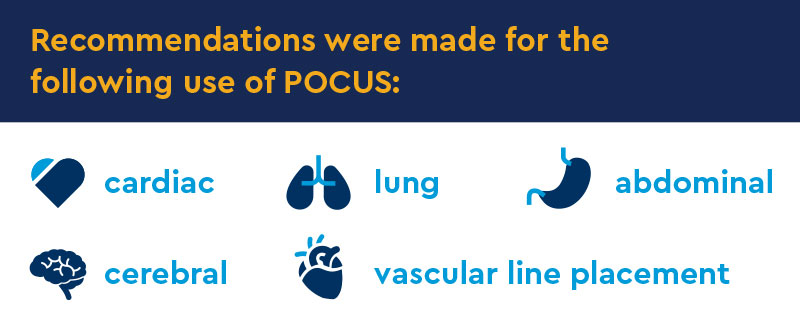Key takeaways
-
POCUS has become an essential tool in critical care and in emergency medicine and is being used more frequently in neonatal and pediatric critical care.
-
Until now, there were no unified, evidence-based guidelines for the use of POCUS in neonatal and pediatric critical care.
-
The new guidelines will help standardize the use of POCUS in this patient population, develop training and further research.
Research background: creating guidelines for neonatal intensive care and pediatric critical care
Point-of-care ultrasound (POCUS) is viewed as a new clinical tool for diagnostic and procedural medical care, particularly in acute care settings. Its use in critical care has significantly increased in recent years. Adult emergency medicine providers were the first to publish training and implementation guidelines, which were translated for use in pediatric emergency medicine.
Currently, many pediatric disciplines use POCUS since other monitoring techniques aren’t always available. Pediatric echocardiography was the first pediatric application to have implementation guidelines. Non-cardiac use of POCUS shows promise in benefiting the patient and provider, but there are no unified guidelines on using and training POCUS for pediatric critical care or neonatal critical care.
As more acute care providers invest in and use POCUS technology, the main purpose needs to be defined, and formal training and accreditation guidelines are needed to maximize benefits and reduce risks. The European Society for Pediatric and Neonatal Intensive Care (ESPNIC) assembled a working group of international pediatric POCUS leaders to create evidence-based guidelines for clinical use in neonatal and pediatric intensive care units.
Research methods: identifying international experts in the POCUS field
Eduardo Da Cruz, MD, Associate Medical Director of the Heart Institute at Children’s Hospital Colorado, was one of 19 experts from Europe and North America invited by the lead authors (a neonatologist, a pediatric intensivist and a pediatric cardiologist) to participate in the creation of the guidelines.
Participants were selected for their significant contributions to publications in the POCUS field and/or they have developed POCUS training courses within the past decade. A search of published literature was performed, the level of evidence was assessed according to a GRADE method and recommendations were made after consensus, evaluation and blind voting.
Research results: reaching agreement on the recommended POCUS guidelines
The group met in person to discuss methodology, define five subsections and phrase 41 recommendations. The first round of online voting resulted in strong agreement on 22 of the recommendations. The experts met in person again during the 2018 ESPNIC congress and the 19 recommendations that were not agreed on were reworded and discussed. The second round of online voting resulted in agreement of all but two of the remaining recommendations. In the end, the group agreed on 39 of 41 recommendations, with 28 recommendations based on moderate quality of evidence.

-
POCUS should not be used as a screening tool for diagnosing congenital heart defects in neonates and children, unless neonatologists/pediatric intensivists have received an advanced echocardiography training specifically for this purpose.
-
POCUS may be helpful to assess cardiac filling (preload assessment) and intravascular volume status in neonates and children.
-
POCUS may be helpful to assess fluid responsiveness in neonates and children.
-
POCUS may be helpful for qualitative assessment of cardiac function on visual inspection in neonates and children.
-
POCUS is helpful for semi-quantitative assessment of cardiac function in neonates and children (however, a detailed functional assessment should be performed by a provider with advanced echocardiography training).
-
POCUS is helpful for the assessment of pulmonary artery systolic pressure in pulmonary hypertension in neonates and children.
-
POCUS is helpful for semi-quantitative assessment of pulmonary hypertension in neonates and children.
-
POCUS is helpful to diagnose pericardial effusion in neonates and children.
-
POCUS is helpful to guide pericardiocentesis in neonates and children.
-
POCUS should be used to assess the patency of ductus arteriosus in neonates and children.
-
POCUS may be used to detect vegetation to make or exclude the diagnosis of endocarditis (however, a definitive diagnosis requires a detailed assessment by a pediatric cardiologist).
Research discussion and conclusion: standardizing use of POCUS with guidelines aids research and training
The use of POCUS in neonatal and pediatric critical care is increasing and is a valuable addition to other clinical tools. Clinician use of POCUS is different than a specialist’s in-depth diagnostic study, because it can be performed and interpreted by the same non-specialized provider, be rapidly implemented in the current clinical setting, and repeated to identify any changes. POCUS can provide information that can be combined with clinical and laboratory data to enable timely and accurate decisions.
Panelists disagreed on two indications regarding endocarditis and hypertrophic pyloric stenosis, which should be diagnosed by a detailed ultrasonography and performed by an expert pediatric cardiologist or radiologist. The role of POCUS for these indications is not clear, but in general, the role of ultrasound remains important.
There are still variations in clinical practice regarding indications, training and clinical governance. The guidelines subdivided POCUS recommendations based on estimated training required for their use. The scope of practice for these guidelines were developed for the targeted use of ultrasound in neonatal and pediatric critical care units by neonatologists or pediatric intensivists, as well as by emergency providers. All ages of neonates and children are covered for most of the diagnostic (heart, lungs, brain and abdomen) and procedural (line placement and fluid drainage) applications.
For cardiac POCUS in neonates, it should not be used as a screening or diagnostic tool for congenital heart defects. Patients suspected of critical congenital heart defects should be quickly referred to a pediatric cardiologist. Nonetheless, in an emergency setting, it can still identify some life-threatening conditions, enabling the provider to deliver real-time lifesaving interventions.
The guidelines are not prescriptive, but can help standardize clinical practice across acute care settings. While not a training statement, the guidelines may help develop POCUS curriculum and structured training programs.
POCUS was already increasingly being used despite the lack of published evidence-based guidelines for use in neonatal and pediatric critical care. These new guidelines provide the basis for use in this setting and guide future research and may help standardize clinical practice and strengthen clinical governance.
Featured Researchers
Eduardo da Cruz, MD
Pediatric cardiologist
Children's Hospital Colorado





 720-777-0123
720-777-0123










